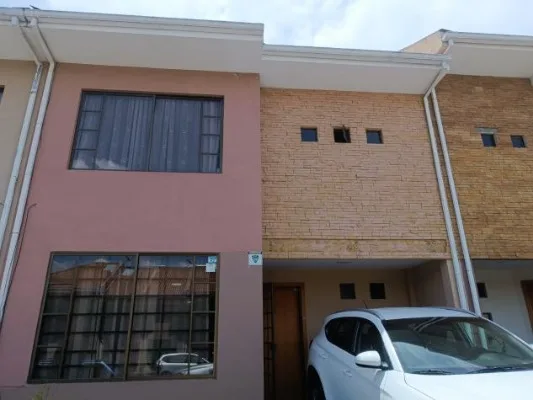Cuenca’s Botanical Garden, a natural wonderland, is making plans for a major expansion

Willow and Eucalyptus trees line the Yanuncay at the botanical park. A study will be conducted to address the abundance of Eucalyptus trees.
By Stephen Vargha
Cuenca’s garden secret is on pace to triple in size.
“I’m amazed at how few people know about the place,” said an American expat who has lived in Cuenca for several years.
The American expat is referring to the Cuenca Botanical Garden. Located on the eastern tip of the barrio, La Isla, it currently sits on 5.6 hectares / 13.8 acres. The park is bordered by Paseo Río Jadán on the western side and by the Yanuncay River and the Tarqui River on the other sides.

An educational building at the botanical reflects in the water garden.
It is just the first phase of making Cuenca greener. “We have the advantage of four rivers to make public green spaces, so we have more than other cities in Ecuador and Latin America,” said Javier Gonzalez, Coordinator and one of the architects of the botanical park’s development.
“Cuenca currently has 4.5 square meters (48.4 square feet) per resident,” Gonzalez said. “The goal is seven to nine square meters (75 to 97 square feet) per person. We are well on our way with this project.”

Curving walkways and bridges are a pleasing part of the botanical garden, located on the eastside of La Isla.
Gonzalez is talking about Phase 2 of the botanical park. Not much has been said about it as three city architects, Gonzalez, Patricio Alvarez, and Caridad Amoroso, are working on the final details for adding 11 hectares (27 acres) to the existing park.
The design for the northern part of Phase 2 has been completed. They hope to have everything ready to present to government officials by the end of April.
The addition to the botanical park is two pronged: The longer northern portion would follow the Yanuncay River from the existing park all the way to Tres Puentes, at Av. Fray Vicente Solano. Their goal is to spotlight the middle and original bridge that was built in 1904.

The Tarqui River will be the southern portion of Phase 2 of the Cuenca Botanical Garden.
This new portion of the botanical park would connect with Parque Lineal Yanuncay. That park was informally voted online by expats as the best walk outside of El Centro.
And to complete the greenspace on the north side of the Yanuncay River, Bomberos station #3 on Ave. 27 de Febrero will be purchased and converted into park land.
The shorter southern portion would start at the existing park and follow the Tarqui River to Av. 24 de Mayo. Basically, Phase 2 would wrap itself around La Isla.
Cuenca Botanical Garden was an idea that took many years to come to fruition. In 2008, under Mayor Marcelo Cabrera, the decision was made to begin the project.

The botanical garden is located where the Yanuncay andTarqui Rivers merge.
“We immediately began the process of buying the land,” said Gonzalez. “The legal process in Ecuador is very complicated. Even with the right to buy the land, it took a very long time.”
In 2015, Gonzalez and his colleagues began the designing of Phase 1 of the botanical park. “La Isla was the perfect place to put the botanical park,” said Gonzalez. “Since the project focuses on natural things, putting it where the Yanuncay River and Tarqui River merge was the right place to put it.”
The goal of the architects was to make it a pleasing place for visitors to spend a lot of time. “We decided to create a snake-like pattern walkway for people to see more and enjoy more,” said Gonzalez.

Map showing where Phase 2 will be located. La Isla will basically be bordered by the botanical garden.
“It would not take long to go through the three hectares (7.4 acres) of the park if the walkways were a straight line,” said Alvarez. “The walkways total 1.3 kilometers (4,300 feet), but it does not feel that long with all of the curves.”
Two pedestrian bridges were part of Phase 1. One goes over the Tarqui River to the southern portion of the botanical park. The more important pedestrian bridge connects La Isla with Av. 27 de Febrero, on the north side of the Yanuncay River.
“We want to make Cuenca a walkable city. So, we built the pedestrian bridge over the Yanuncay,” said Amoroso. “Now, we are thinking of building one over the Tarqui River in Phase 2 as well as another one over the Yanuncay River that will be between the current pedestrian bridge and Tres Puentes.”

A pedestrian crosses the bridge over the Yanuncay River at night. Architects say the goal is to make Cuenca a very walkable city.
The first phase focused on research and laboratories that are used by the University of Azuay. “The most critical parts of the botanical park are research and education,” said Alvarez. “Recreation is a third integral part.”
That is why some areas of the botanical park have bigger plants and plants that seem healthier than others. Plants near the entrance to the botanical park are native to Cuenca and Azuay province.
Other plants, including those on the portion south of the Tarqui River, are from other parts of Ecuador. Amoroso said those plants could take five years to take hold and be of a good size.
Phase 2 will be more about public spaces. “This project is more than botanical,” said Alvarez. “It is urban, which is an important part of the park.”
“We are planning on having lots of plants that are native to southern Azuay province,” said Gonzalez. “There will be walkways and areas to exercise. Like Parque Lineal Yanuncay, there will be dedicated areas for working out and for outdoor activities such as basketball and ecuavóley.”
All three architects said growing plants will face more challenges in Phase 2 and Phase 3, which will be 8.4 hectares / 20.8 acres east of where the Yanuncay River and Tarqui River merge and which has no planning date. They said there is less control with so much space open to the public.
Eucalyptus trees grow in abundance along both rivers. The trees were first introduced from southern Australia to Ecuador in the late 1800s. They tower over everything as they can reach 60 meters / 200 feet into the sky.
Though considered an invasive species, the trees cannot be removed without a plan. “We cannot cut down a Eucalyptus tree without replacing it with something else,” said Gonzalez. “We want to conserve as much as possible so there will be a conservation study before proceeding.”
Having the two clean rivers as part of the botanical park is key. The architects said that 95 percent of the water is recycled at the water treatment plant that is just northeast of the city.
None of the architects said when they thought Phase 2 would be completed. Money has to be found for the project and private property needs to be purchased. But all three did think the botanical park could become the crown jewel of Cuenca.
“It’s like bringing in the mountains and forest and putting it all into one place in the city,” said Gonzalez.
____________________
Cuenca Botanical Garden (Jardín Botánico de Cuenca), Paseo Río Jadán, 8:00 a.m. to 6:30 p.m.
Photos by Stephen Vargha
Stephen Vargha’s new book about Cuenca, “Una Nueva Vida – A New Life” is available at Amazon in digital and paperback formats.


















